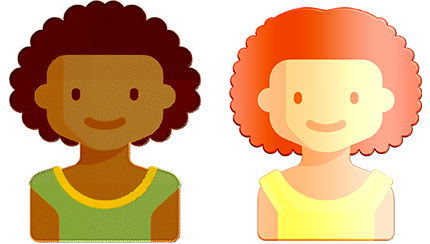Variations on a Human Face - Heredity Simulation

Materials: 2 pennies, chart on human traits
Single Allele Traits
1. Determine which partner will toss for the male and which will toss for the female.
2. Have the parent who is representing the male flip the coin, if the coin lands heads up, the offspring is female, if tails, then the offspring is male. What sex is your offspring?
3. For all coin tosses from now on, heads will represent the dominant allele and tails will represent the recessive allele. For each trait on the chart, you will flip a c coin to determine the GENOTYPE of your offspring. Put a check in the box that represents your offspring's appearance, or PHENOTYPE.
Example: For the shape of the face, your partner tossed heads and you tosses tails. This means the offspring's genotype is Rr and the child will have a round face, so check that box. If you had both tossed tails, you would check the square-shaped face (rr) and if you had both tossed heads, you would have a round shaped face (RR)
Polygenic Traits - Hair, Eye, Skin
Some traits are controlled by more than two genes, such as hair color, eye color and skin color. For these traits you will need to perform a different procedure to determine your offspring's phenotype.
Hair color
Dark hair is dominant over light. To determine the color of the offspring’s hair, assume there are two gene pairs involved (there are actually probably more than that, but for the purpose of this activity, let’s not go crazy). Flip your coin first to determine the genotype of the first pair of alleles (AA, Aa, or aa). Now, flip the coins again to determine the genotype of the second pair of alleles (BB, Bb, or bb). Match the genotype you have to the hair color on the chart. Circle your offspring’s hair color.
| If the genotype is.... | The hair color is.... |
| AABB | black |
| AABb | black |
| AAbb | red |
| AaBB | brown |
| Aabb | regular blonde |
| AaBb | brown |
| aaBB | dark blonde |
| aaBb | regular blonde |
| aabb | pale yellow blond |
Eye Color
To determine the color of the offspring’s eyes, assume there are two gene pairs involved, one which codes for pigment in the front of the iris, and one which codes for pigment n the back of the iris. Determine the genotype of the first pair (AA, Aa, or aa) Then flip again to determine the genotype of the second pair (BB, Bb, or bb). Use the chart below to find out what eye color your offspring has and circle it.
| If the genotype is.... | The hair color is.... |
| AABB | dark brown |
| AABb | dark brown |
| AAbb | brown |
| AaBB | brown with green flecks |
| Aabb | brown |
| AaBb | gray |
| aaBB | green |
| aaBb | dark blue |
| aabb | light blue |
Skin Color
Skin color is controlled by a lot of different genes that basically add together to determine how dark the skin is and variations in tone. To simulate how skin color might be determined. Flip a single coin 10 times. Each time the coin turns up heads, give your offspring a point. Add your points together. 10 pts would be a very dark child and 1 pt would be a very pale child. How many points does your child have? __________
**Now that you have determined all the traits of your child. You will draw a picture. Use colors and try to make the sketch as accurate as possible given the traits your child inherited. Make sure you name your child too! **
Analysis and Conclusions
1. Was your child exactly like any other child in the room? What do you think the odds were that two children in the room would turn out exactly alike?
2. How might it be possible for you to show a trait that neither of your parents have?
3. Which traits are codominant or incompletely dominant? (these traits don’t have a clear dominant or recessive, the heterozygous condition shows a “blending” or a “middle” condition)
4. Why did you have to flip the coin twice to determine hair and eye color?
5. Show the cross of a wavy haired person with a wavy haired person. Use a Punnet square.
Related Resources
Simple Genetics Practice - using mendelian genetics and Punnett squares
Peas, Please - practice setting up squares for basic Mendelian traits in pea plants (Key, TpT)
How to Solve Dihybrid Crosses - step by step guide on setting up 4x4 squares and determining ratios
